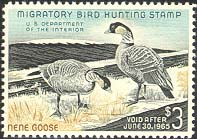

Back to RW31 Back to the Federal Index Home
A LITTLE HISTORY ON THE 31ST (1964-65) DUCK STAMP ARTIST


Before he gained his new interest in art, he and his wife, Jean Pride, had been liv8ing in her hometown of Island Falls, where he worked for her father in the lumber business. He had later opened a small business of his own in boat building. Neither occupation offered much of a future.
When he was 24, in June of 1950, Mr. Stearns decided to try and find a business with future for him. With financial aid from his father and the Pride family, he went to art school in Boston. He left his wife, his three-year-old son, and his one-year-old daughter in Maine until funds from the G.I. Bill allowed them to join him six months later.
Mr. Stearns was finally forced to leave school because the financial grind left him no time to apply what he had learned. During a year and a half of foundation courses at Vesper George, Mr. Stearns had attended classes during the day and waited on tables in nightclubs for a full eight hours in the evening. Around midnight, he would return home to the south end apartment, and stay up for two or three hours doing homework. Often, he would fall asleep over his "studio"--a card table in the corner.
In the fall of 1952, Mr. Stearns got a job as a technical illustrator in the engineering laboratory of International Business Machines Corporation in Endicott, New York. His family moved to Binghamton, a sister city of Endicott.
After that, he worked as an industrial designer, styling a computer for the Navy. Then he worked as a communications specialist in liaison between engineering and management. Because of his educational background, he was able to interpret engineering concepts visually; He soon spent much of his time doing "easel-sheet" proposals for the engineers of the planning groups to use in expressing their ideas. He did thousands of easel sheets, and illustrated hundreds of reports, books, and catalogs.
Mr. Stearns was still doing artwork at home during these eight years in New York. He worked in many media and with varied subjects including landscapes, seascapes, city scenes, figures, and portraits. He turned to wildlife subjects as time went on. His first sale of wildlife art was a group of scratchboard. "spots" for the American Rifleman.
-------------------------THE ART-------------------------
Nene Geese was done in watercolor wash and gouache. The print is a stone
lithograph, hand pulled using black ink on whit Rives heavy paper. The print is hand
signed in pencil but not numbered. The image size of the print is 7 1/2" x 10
1/2". This was Stanlye Stearns second win in the Duck Stamp contest..
-------------------------THE STAMP-------------------------
Nene Geese...Engraved by the Federal Bureau of Engraving from the original artwork.
Printed in cerulean blue, khaki, yellow, and bluish black ink. , and black ink. The stamp
sold for three dollars. Postal records show 1,565,860 stamps sold. First day
of sale was July 1, 1964.
Most of the information contained above is from the book Federal Duck Stamp Story, Fifty Years of Excellence, by Laurence F. Jonson; Alexander & Co. It is used here with permission from the author. For more information on this book, please click here.